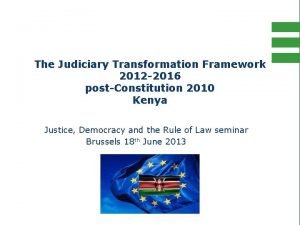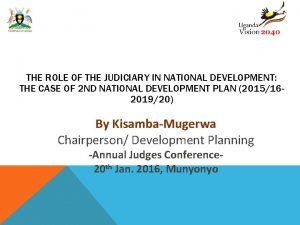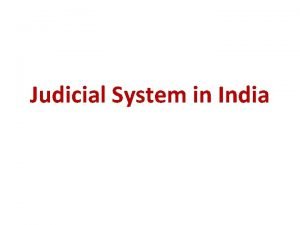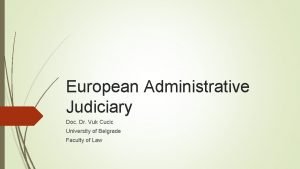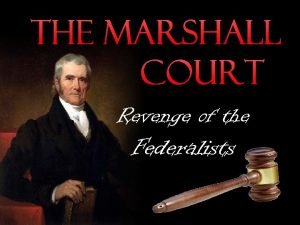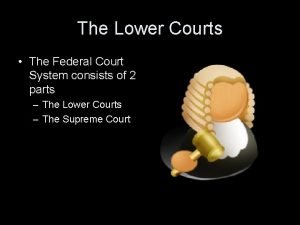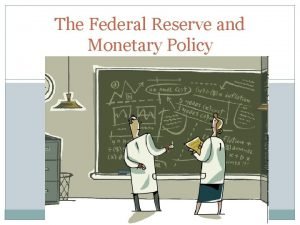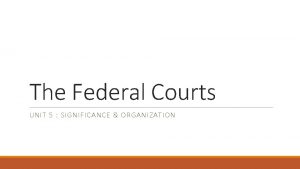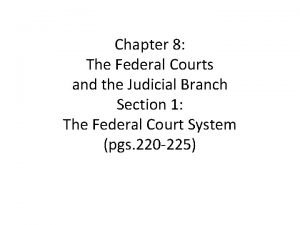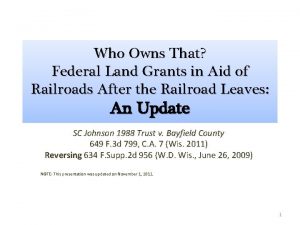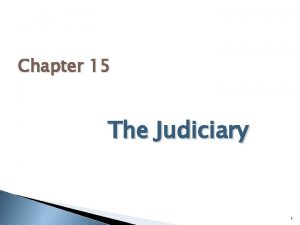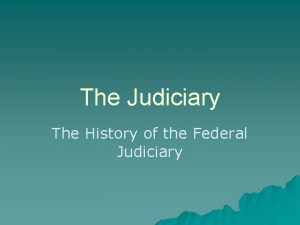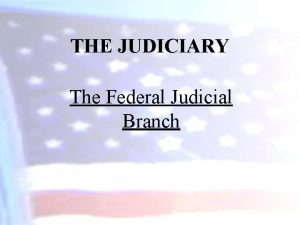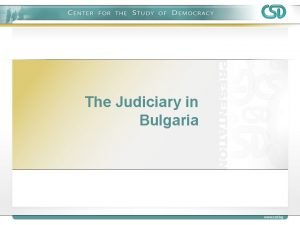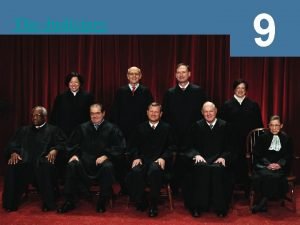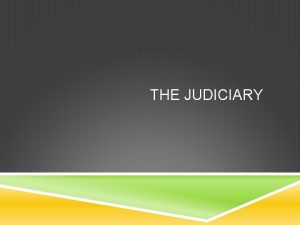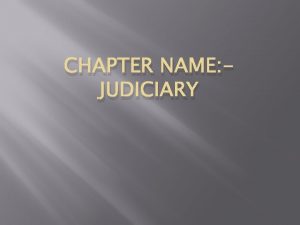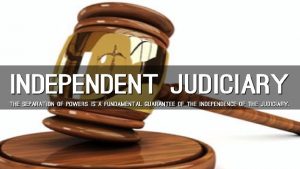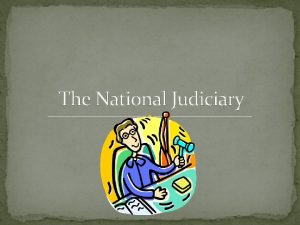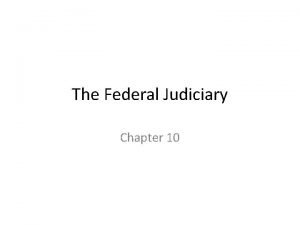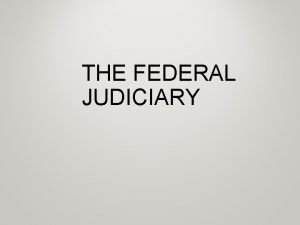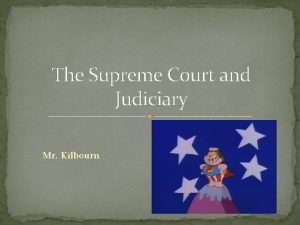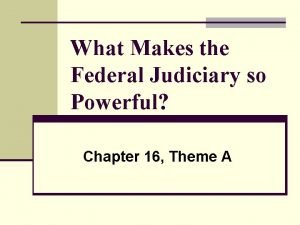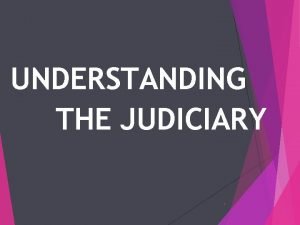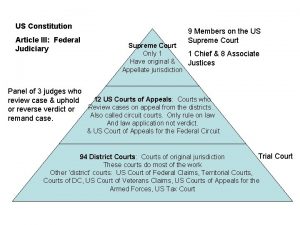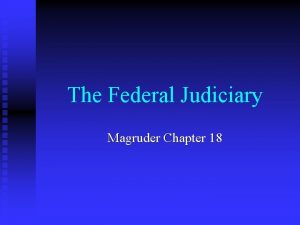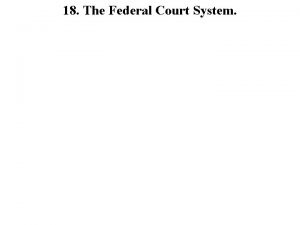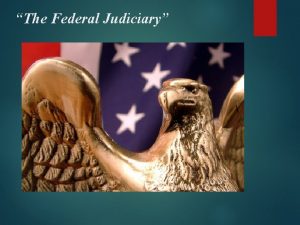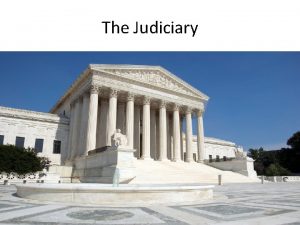The Federal Judiciary The Structure of the Federal



























- Slides: 27

The Federal Judiciary


The Structure of the Federal Judicial System


Important Terms. . . Attorney General Solicitor General Plaintiff Defendant “standing” to sue who is authorized to start a lawsuit Habeas corpus an arrested person must be informed of charges against them.

The Supreme Court

The Constitution & the Supreme Court: 1. Identify the constitutional requirements for appointing Supreme Court Justices. 1. Discuss the purpose and significance of federal judges servings life terms. 1. How do these constitutional provisions promote checks and balances of the three branches of the federal government?

The U. S. Constitution and the Appointment of Supreme Court Justices Article II, Section 2* “He shall have Power, by and with the Advice and Consent of the Senate …to… nominate Judges of the Supreme Court…. ”

The U. S. Constitution and the Supreme Court Article III “The judicial Power of the United States, shall be vested in one supreme Court, and in such inferior Courts as the Congress May …establish. The Judges, both of the supreme and inferior Courts, shall hold their Offices during good Behavior…”

Judicial Review… Marbury v. Madison (1803) Reviews Constitutionality of: State and federal legislation Actions of chief executives Decisions of other courts

What does this cartoon tell us about factors considered in the nomination/confirmation process?

Factors That Influence Supreme Court Nominations Party affiliation Judicial Philosophy “Litmus Test” where nominees stand on controversial issues like abortion Background of nominee (education, experience, race, gender, ethnicity, etc. ) Political favors Interest group input American Bar Association certification Securing a “safe” nominee

U. S. Supreme Court Confirmation Process WHITE HOUSE REVIEW Stage 1: Presidential Nomination Stage 2: Senate Judiciary Committee Hearing Certification FBI Investigation INTEREST GROUP Influence MEDIA Influence Stage 3: Full Senate Vote Stage 4: Oath of Office?




I will take this case all the way to the Supreme Court … • Writ of Certiorari • (i. e. "Rule of Four”) – Annual docket = 8, 000 cases • Fewer than 100 heard or reviewed • $300 filing fee – In forma pauperis= right to be heard at no expense. – Often, interest groups will foot the bill. • Quorum = 6

1. Every Friday, the judges meet in their chambers to debate the cases and decide whether or not to grant cert. “No one speaks twice before everyone speaks once. ”

The Supreme Court in Action 1. After cert has been granted… 2. Lawyers for each side submit a brief, which sets forth the facts of each case and summarizes lower court decisions. 3. Oral arguments before court. (no more than ½ hr. )

1. Decision Rendered Types: Per curiam Majority Opinion Concurring Opinion Dissenting Opinion

Impact of Rulings When making their decisions, SC justices consider the following: 1. Stare Decisis “let the decision stand”/precedent. . . Why important? 1. 2. 3. 1. 2. Stability Legitimacy Equality Personal Ideology (Activism vs. Restraint? ) Public Opinion

Judicial Activism vs. Judicial Restraint Judicial Activism Judicial Restraint The tendency of judges Those who believe that to interpret the Supreme Court in its Constitution according rulings should defer to to their own views the elective institutions of government Judges should discover general principles underlying the Belief that judges should Constitution, amplify only judge them, and apply them to Confine to applying cases. rules clearly stated in the language of the Constitution.

Activity: Activism or Restraint? 1. Justice Harry Blackmun in dissenting opinion in Furman v. Georgia (1972) (voided the death penalty) stated, "Cases such as these provide for me an excruciating agony of the spirit I yield to no one in the depth of my distaste, antipathy, and indeed abhorrence, for the death penalty. Were I a legislator I would vote against the death penalty. . I do not sit, however, as a legislator. . . our task here. . . is to vote, and pass on constitutionality of legislation that has been enacted and that is challenged. This is the sole task for judges. We should not allow our personal preferences as to the wisdom of legislative or congressional action, or our distaste for such action to guide our judicial decision. ”

Activity: Activism or Restraint? 2) Justice Stephens in Clinton v. New York City (line-item veto) argues that the law is unconstitutional in part, because Article II section 7 states that a bill be "presented to the President of the United States if he approve he shall sign it, if not he shall return it. " This leaves no room for another option.

Activity: Activism or Restraint? 3) In Texas v. Johnson (1989) Justice Brennan found that Johnson's conviction for flag desecration is inconsistent with the first amendment. “The first amendment forbids the abridgment only of 'speech' but we have long recognized that its protection does not end at the spoken word. ”

Public Opinion The Courts do not deviate too far from public opinion 1. Reliance on other public officials to execute decisions. 2. May be overruled with new laws or constitutional amendments. 3. Concern for its reputation/credibility. 4. The potential for the impeachment of judges. 5. Congressional control of the Supreme Court’s appellate jurisdiction and/or changing the number of justices on the Court.

However… The Supreme Court is insulated from public opinion by: Appointed, not elected Serve life-terms Court’s ability to control its own docket/set its own agenda. Salaries cannot be reduced. Limited access to Court proceedings
 Judicial transformation framework
Judicial transformation framework Judicial activism cases
Judicial activism cases Cohesive society and preserved identity
Cohesive society and preserved identity Department of judiciary
Department of judiciary 3 types of courts in india
3 types of courts in india Vuk cucic
Vuk cucic Whats the judiciary act
Whats the judiciary act Federal court system structure
Federal court system structure Structure of the federal reserve
Structure of the federal reserve The us federal
The us federal Dual court system answer key pdf
Dual court system answer key pdf Federal court structure
Federal court structure Hình ảnh bộ gõ cơ thể búng tay
Hình ảnh bộ gõ cơ thể búng tay Lp html
Lp html Bổ thể
Bổ thể Tỉ lệ cơ thể trẻ em
Tỉ lệ cơ thể trẻ em Chó sói
Chó sói Glasgow thang điểm
Glasgow thang điểm Hát lên người ơi alleluia
Hát lên người ơi alleluia Môn thể thao bắt đầu bằng chữ đua
Môn thể thao bắt đầu bằng chữ đua Thế nào là hệ số cao nhất
Thế nào là hệ số cao nhất Các châu lục và đại dương trên thế giới
Các châu lục và đại dương trên thế giới Cong thức tính động năng
Cong thức tính động năng Trời xanh đây là của chúng ta thể thơ
Trời xanh đây là của chúng ta thể thơ Cách giải mật thư tọa độ
Cách giải mật thư tọa độ Phép trừ bù
Phép trừ bù độ dài liên kết
độ dài liên kết Các châu lục và đại dương trên thế giới
Các châu lục và đại dương trên thế giới
